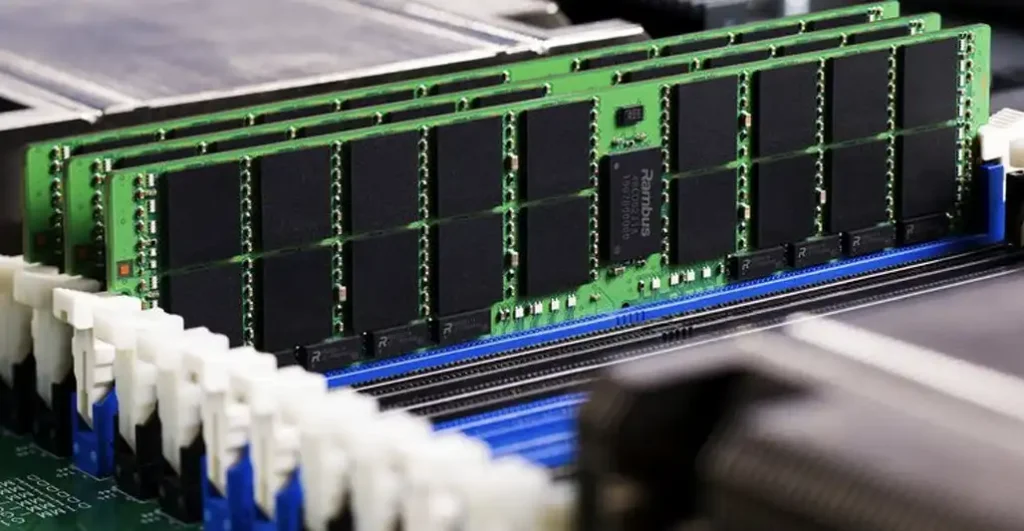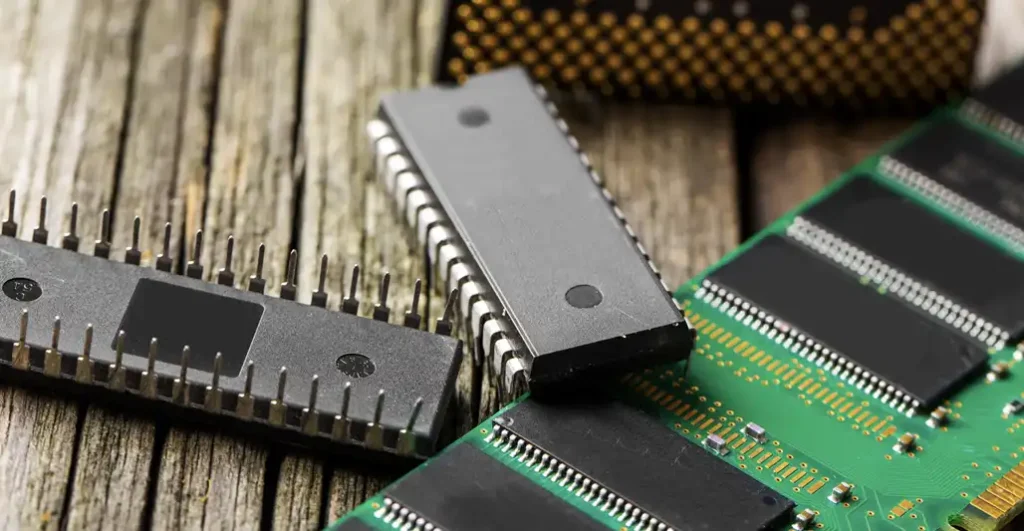Memory Chips Types are essential components in modern electronics, from smartphones to computers. Whether you’re building a PC or upgrading your devices, understanding the differences between DRAM, SRAM, flash, and other memory chip types can help you make the right choice.
Each type has unique benefits and applications, affecting speed, performance, and power efficiency. Ready to dive deeper into the world of Memory Chips Types? Let’s explore how these chips power your tech!
What Are Memory Chips?

Memory chips are small but powerful components that store data in electronic devices like smartphones, computers, and cameras. They hold everything from system data to user files, enabling fast access and smooth operation.
The most common types are DRAM, SRAM, and flash memory. Each type has specific strengths—DRAM is fast but temporary, SRAM is faster but costlier, and flash memory is non-volatile, storing data even when powered off. Memory chips are essential for keeping your tech running efficiently.
Memory Chips Types

Memory chips are essential components in all digital devices, responsible for storing data. They come in various forms, each with distinct characteristics that make them suitable for different applications. Here’s a breakdown of the major types of memory chips:
Volatile vs. Non-volatile Memory
The primary distinction between memory chips lies in their data volatility. Volatile memory loses its stored data when the power is off, while non-volatile memory retains data even without power.
Volatile Memory (RAM): Stands for Random Access Memory. It allows for fast reading and writing of data, making it ideal for a computer’s working memory (RAM) where frequently accessed programs and data are stored. Common types of RAM include:

Dynamic RAM (DRAM): The most prevalent type of RAM, offering high density at a lower cost. However, DRAM needs constant refreshing to retain data, making it slightly slower than SRAM.
Static RAM (SRAM): Faster than DRAM but more expensive and consumes more power. SRAM is used for cache memory in processors due to its speed advantage.

Non-volatile Memory (ROM): Stands for Read-Only Memory. Data in ROM can only be read and not easily modified. ROM is typically used to store permanent data like firmware or the BIOS in a computer. There are also programmable variations of ROM:
PROM (Programmable Read-Only Memory): Data can be written to PROM once using a special high-voltage pulse.
EPROM (Erasable Programmable Read-Only Memory): Data in EPROM can be erased with ultraviolet light and then reprogrammed.
EEPROM (Electrically Erasable Programmable Read-Only Memory): Data in EEPROM can be erased and reprogrammed electrically, offering more flexibility.
Flash Memory: A type of EEPROM that allows for rewriting specific blocks of memory rather than the entire chip at once. Flash memory is widely used in USB drives, solid-state drives (SSDs), and memory cards.
Other Memory Types
Besides the categorization of volatile and non-volatile, there are other emerging memory technologies:
- FRAM (Ferroelectric RAM): A type of non-volatile memory that offers faster read/write speeds than traditional flash memory and is more resistant to write wear.
- MRAM (Magnetoresistive RAM): A non-volatile memory that uses magnetic fields to store data. MRAM is still under development but holds promise for high-speed, low-power applications.
The choice of memory chip depends on the specific needs of the device. Factors like speed, density, power consumption, and cost all play a role in selecting the most suitable memory type.
TOP 3 Memory Chips Types Contained In The Motherboard

Out of the various memory types, three commonly found on a motherboard are:
RAM (Random Access Memory):
This is the workhorse of a computer’s memory, responsible for storing data and instructions the CPU needs for ongoing tasks. Unlike other memory types, RAM is volatile, meaning it loses its content when the computer shuts down. Think of it as your computer’s notepad – it holds information you’re actively working on. There are different RAM types, with DDR4 being the most common these days.
ROM (Read-Only Memory):
This chip contains permanent instructions essential for the computer to boot up (starting process) and carry out basic functions. Unlike RAM, ROM is non-volatile, meaning its contents are retained even after a power off. Imagine ROM as a factory-set instruction manual for the computer’s most critical tasks. There are different ROM types as well, but a common subtype used on motherboards is BIOS (Basic Input/Output System), which contains the startup instructions.
CMOS (Complementary Metal-Oxide-Semiconductor):
This tiny chip stores configuration settings for your motherboard, such as system time, date, and hardware configurations. The key difference here is that CMOS is powered by a small battery even when the computer is off, allowing it to retain these settings. Think of CMOS like a set of dials and switches that define how your computer operates.
While these are the main three, some motherboards may also include Flash memory, a type of non-volatile memory that can be rewritten unlike traditional ROM. This can be used for storing updates to the BIOS.
Chip Select in Memory
Sure, I can provide more information on the concept of Chip Select in memory.
Chip Select in Memory
Chip Select (CS) is a control signal used in digital electronics, particularly in memory systems, to enable or disable a specific memory chip or component. It is an important mechanism for selecting and accessing the desired memory location within a memory system.
Here’s how Chip Select works:
- Memory Organization: In a memory system, there are typically multiple memory chips or modules connected to a common data bus, address bus, and control bus. This allows the processor or memory controller to access different memory locations by selecting the appropriate chip.
- Chip Select Signal: The Chip Select signal is a control signal that is used to activate or deactivate a specific memory chip. When the Chip Select signal is asserted (typically by setting it to a logic high level), the corresponding memory chip is enabled and can be accessed. When the Chip Select signal is deasserted (typically by setting it to a logic low level), the memory chip is disabled and cannot be accessed.
- Address Decoding: The Chip Select signal is often generated through address decoding logic. The processor or memory controller uses the address bus to specify the desired memory location, and the address decoding logic determines which memory chip should be selected based on the address range.
- Multiple Memory Chips: In systems with multiple memory chips, the Chip Select signals are used to select the appropriate chip. For example, in a system with four memory chips, the processor or memory controller might use two Chip Select signals to select one of the four chips.
- Memory Expansion: Chip Select signals also allow for memory expansion by enabling the use of additional memory chips. By adding more memory chips and using additional Chip Select signals, the total memory capacity of the system can be increased.
The use of Chip Select is crucial for efficient memory access and management in digital systems. It allows the processor or memory controller to selectively access the desired memory locations without interfering with the operation of other memory components.
How Is Chip Select Used In Memory Systems
Chip Select is an important mechanism used in memory systems to enable or disable specific memory chips or components. Here’s how Chip Select is used in memory systems:
Memory Organization:
In a memory system, there are typically multiple memory chips or modules connected to a common data bus, address bus, and control bus. This allows the processor or memory controller to access different memory locations by selecting the appropriate chip.
Chip Select Signal:
The Chip Select signal is a control signal used to activate or deactivate a specific memory chip.
When the Chip Select signal is asserted (typically set to a logic high level), the corresponding memory chip is enabled and can be accessed.
When the Chip Select signal is deasserted (typically set to a logic low level), the memory chip is disabled and cannot be accessed.
Address Decoding:
The Chip Select signal is often generated through address decoding logic.
The processor or memory controller uses the address bus to specify the desired memory location.
The address decoding logic determines which memory chip should be selected based on the address range.
Multiple Memory Chips:
In systems with multiple memory chips, the Chip Select signals are used to select the appropriate chip.
For example, in a system with four memory chips, the processor or memory controller might use two Chip Select signals to select one of the four chips.
Memory Expansion:
Chip Select signals allow for memory expansion by enabling the use of additional memory chips.
By adding more memory chips and using additional Chip Select signals, the total memory capacity of the system can be increased.
The use of Chip Select is crucial for efficient memory access and management in digital systems. It allows the processor or memory controller to selectively access the desired memory locations without interfering with the operation of other memory components, enabling effective memory management and expansion.
Conclusion
In conclusion, understanding the different Memory Chips Types—DRAM, SRAM, flash, and more—is essential for making informed decisions about your tech needs. Whether you’re after speed, efficiency, or storage capacity, each memory type offers unique advantages.
As technology continues to evolve, knowing which Memory Chips Types suit your devices will keep you ahead of the game. Ready to explore the best Memory Chips Types for your project? Get insights by quoting Memory Chips Types from Weishi today!